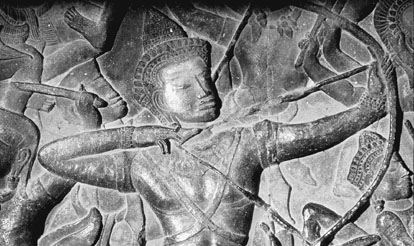

 | Page 246 |  |
at Oc Eo. From 1952 to 1953 Groslier directed archaeological excavations at the Royal Palace that uncovered a cemetery of cremated remains. In the 1950s both Malleret and Groslier investigated prehistoric circular earthwork sites in eastern Cambodia.
After achieving independence in the 1950s, the three countries of Indochina pursued archaeological work to varying degrees. In Vietnam archaeology served nationalistic interests, and efforts were concentrated on finding the roots of Vietnamese civilization. After 1954 the states of North and South Vietnam established the institutes of archaeology in Hanoi and Ho Chi Minh City, respectively. Archaeological work continued unabated in Vietnam throughout the Vietnam War, although research slowed in both Cambodia and Laos during this time. Conservation activities at Angkor went on, as did the historical and epigraphical research that laid the foundations for archaeological interpretations of the monuments.

Bas relief of an archer, Angkor Wat
(Gamma)
A bleak period in Cambodian archaeology began in 1970 with the onset of civil war in the country. All archaeological research activities ceased, and the next five years were plagued by political instability that ultimately forced the closure of the Conservation d’Angkor in 1972, the end of its work in 1973, and the departure of its staff. The Khmer Rouge used Angkor to recall former glory and spared the ruins from the destruction that they wrought on Buddhist temples throughout the country. Angkor was completely abandoned until the end of the Pol Pot regime in 1978, and forces of nature undid much of the clearing work that the EFEO had undertaken to protect the monuments from destruction.
Most of Cambodia’s trained archaeologists and technical experts perished between 1975 and 1978 as a result of the Khmer Rouge plan to eliminate the educated elements of society. With the entry of Vietnamese soldiers in 1979 as part of Vietnam’s occupation of Cambodia, Angkor’s antiquities were pillaged, and Angkorian artifacts (sculpture, architectural elements, other artifacts) flooded the international antiquities market. Only one international team, from India, dared return to Angkor Wat soon after 1979, when fighting between the Vietnamese and the Khmer Rouge continued in the region.
With the Vietnamese withdrawal and the process of reconstruction after 1989, Cambodian
 |  |